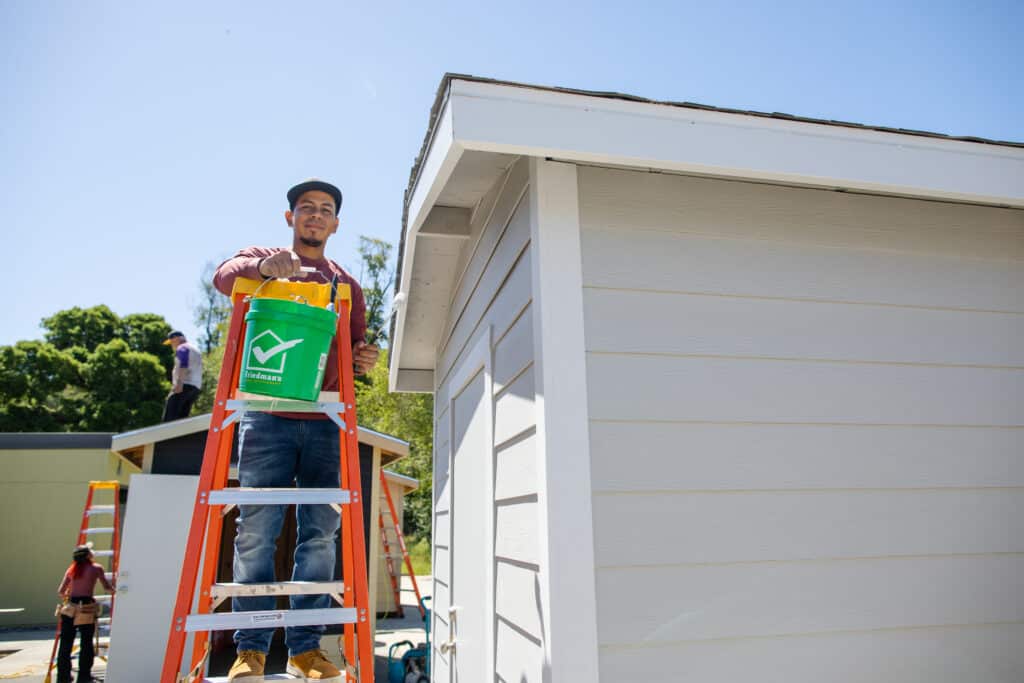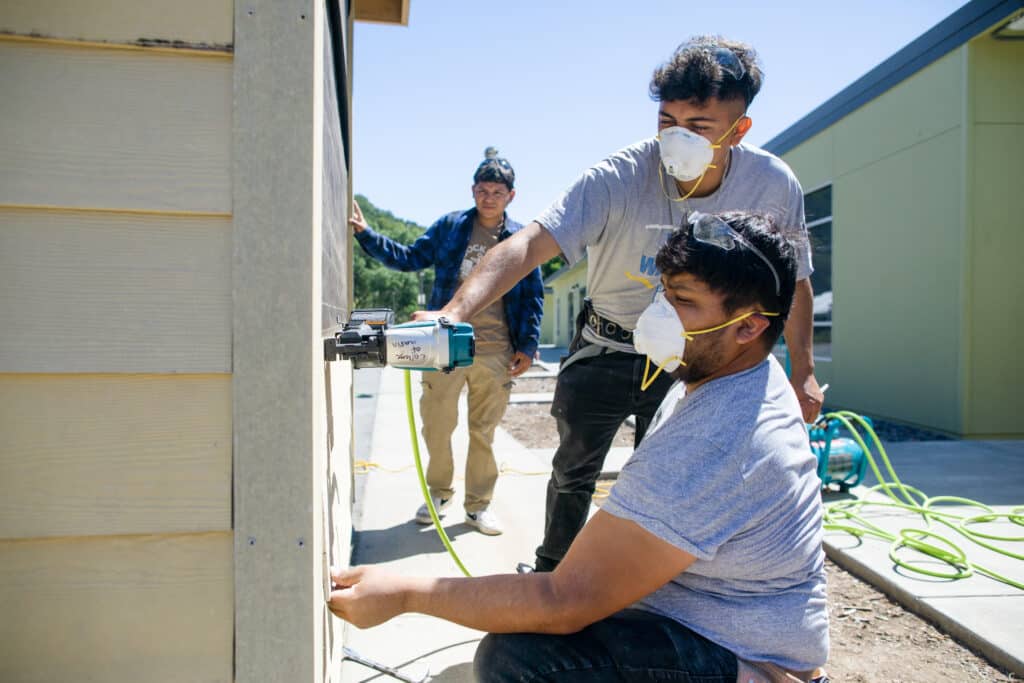From laborer to owner: Latinos are moving forward in North Bay construction
September 17, 2024
by NorthBay biz September 9 2024 in Feature, Lead Story

By Jessica Zimmer
Latinos are utilizing the availability of hands-on training and interaction with local builders’ associations to solidify their standing in North Bay construction. Construction is in demand and offers the potential for good returns, but has huge upfront costs. It can require extensive training and costly supplies, equipment and storage space. Common goals for recent immigrants are increasing fluency in English and becoming familiar with building and safety regulations.
One of the biggest challenges is understanding one another. The Latino community is diverse and is composed of undocumented immigrants, legal permanent residents and U.S. citizens, with family ancestry from a wide range of countries.
Frank Cuneo, director of the North Bay Building Trades Council’s Trades Introduction Program (North Bay TIP), says it is important for programs to build confidence for Latinos and those who support them. North Bay TIP offers a construction apprenticeship readiness training program to residents of all backgrounds from Lake, Marin, Mendocino, Napa, Solano and Sonoma counties.
“When the pandemic hit, many Latinos didn’t know who to trust. So many scams arose. What really worked was when someone from their community helped and when they saw other Latino people complete training programs. We support this to erase a wide variety of barriers,” says Cuneo.
Oscar Rojas, owner of Rojas Painting in Petaluma, says Latinos who are U.S. citizens are an important resource. These individuals tend to be more familiar with safety requirements and do not face obstacles that require a person to be a U.S. citizen.
“I am Mexican American and my crew is composed of Mexican, Mexican American and Guatemalan workers,” says Rojas. “Roughly half of our business is high-end new construction. Our work has to be close to perfect. It helps that I am able to introduce workers who may be new to the U.S. to regulations. That can differ between cities. I also teach my crew how to communicate well with customers.”
There are construction employers in the North Bay that take advantage of recent immigrants, says Isela Gaona. She is a case manager at Kerosky & Gallelli Law in Santa Rosa and a 2024 graduate in Chicano and Latino studies from Sonoma State University.
“One of my classes, Latin American Migration to the United States, involved interviewing workers at the Graton Day Labor Center. Many were willing to take any job they could in construction,” says Gaona.
She adds some of the people from whom she heard stories had crossed two or three borders, worked at jobs where they were underpaid and were not given the right safety equipment.
“They also were not taught safety regulations or how to do work safely,” says Gaona. “Some weren’t given full or any lunch hours or breaks. Others were expected to work through extreme heat. Hearing their stories opened my eyes as to how much needs to change.”

Statistics and the stories behind them
Nationally, 40.8%, or more one in three, construction workers are Hispanic, according to the 2023 Current Population Survey published by the U.S. Bureau of Labor Statistics. The term “Hispanic” means a person from a Spanish-speaking country. The term “Latino” means a person of Latin American descent. This includes people from Portuguese-speaking countries such as Brazil and English-speaking countries like Belize.
California has a higher percentage of Hispanic workers in construction, close to 55%. The figure has the potential to increase because Hispanics’ participation in the labor force has not returned to pre-COVID levels. The information comes from a 2023 report from The Libre Institute, a Virginia-based nonprofit that engages and informs the U.S. Hispanic community.
It is difficult to pin down the number of Hispanic people in Marin, Napa and Sonoma counties who work in construction. The number is constantly changing, due to fluctuations in the workforce. It is also likely to be underreported. Some undocumented immigrants and employers can be hesitant to share information. In addition, a number of individuals work side jobs in construction and hold primary jobs in other fields, like agriculture.
The number of Hispanic people in the construction labor force has markedly increased over time. In 2013, nationally, only one in four construction workers was Hispanic.
Liliana Gallelli, attorney and partner in Kerosky & Gallelli Law in Santa Rosa, says the national background of Latinos who are recent immigrants varies by county. “In Marin County, most of the recent immigrants our firm serves are from Guatemala. In Napa, the majority are from Mexico. In Sonoma County, most of the recent applicants are from Mexico. We have seen a growing number of people from Colombia, Peru and Venezuela,” says Gallelli.
The influx of people from the last three countries is tied to the political and economic crisis in Venezuela, which has seen over 7.7 million people flee the country as of August 2023. This is currently the largest out-migration in the world. Venezuela’s weak economy, which crashed in the mid-2010s, has worsened. Venezuelans who had migrated to Chile, Colombia, Ecuador and Peru have become frustrated with the scarcity of economic opportunities. Many are making a second trek to the U.S.
Richard Martinez, chief program officer for Canal Alliance, a San Rafael nonprofit that serves the Latino community, added there are also recent immigrants from El Salvador, Mexico and Nicaragua in Marin County. He says many Latino immigrants in Marin come from remote, rural areas.
For individuals coming from Mexico, the state of origin is important. This is because immigrants often come to where there is a community of people from their area.
“In Sonoma County, most people coming from Mexico are from Michoacán. In Marin County, about 35% of recent Guatemalan immigrants seen at our firm are indigenous. Spanish is not their first language. They are usually Mam or Quiche speakers,” says Gallelli.
Latino immigrants come to the North Bay for economic opportunity and to join family members already here. They also come because of problems relating to safety and racism in their home country.
“Women who enter alone often are fleeing domestic violence and the lack of protection from their government. Indigenous people are subject to insidious discrimination that ranges from lack of protection from criminal groups that target the vulnerable to lack of access to economic opportunity and basic human needs such as schools and hospitals,” says Gallelli.
The level at which a Latino immigrant starts in construction depends on their education, work experience, personal connections and luck.
José Eduardo Vera Velásquez, owner of Bee Vera Construction, Inc. in Healdsburg, came to the U.S. in 1991 from Putla Villa de Guerrero in Oaxaca, Mexico.
“I went to college to be a construction technician in Mexico. When I came to the U.S., I wanted to be an architect. It would have taken too long for me to go back to school for that. So I started working in construction. In 2020, I established my own business,” says Vera Velásquez.
Vera Velásquez says he is still working to become fluent in English. He has taken language classes at Santa Rosa Junior College. One of the big shifts he experienced when he moved to the U.S. was understanding materials.
“In Mexico, we mostly use brick, concrete and rebar. In the U.S., we use more materials, including different types of wood,” says Vera Velásquez.
Wilber Barrios, owner of Make It Right Carpentry in Novato, came to the U.S. from Guatemala as a teenager. He started working in construction part time at the age of 15 while attending Terra Linda High School.
“After that I was always in construction. I became a carpenter. In 2017, I took a construction class with Canal Alliance. In 2020, I established my own business. I have about eight employees, with most of the crew from Guatemala and one from Mexico. About 75% of my workers already had a background in construction before I hired them,” says Barrios.

The role of training
Multiple programs across Marin, Napa and Sonoma counties train people in construction, the English language and entrepreneurship. These range from hands-on construction programs between one and four weeks to academic programs at colleges and universities.
North Bay TIP offers a 128-hour construction apprenticeship readiness training that shifts its location and type of schedule.
“We aim for 20 people in a cohort and typically a few drop out. We and our grant partners can offer financial assistance for gas money, childcare and other support. The course prepares graduates for apprenticeship and a career in the trades,” says Cuneo.
One of the most significant components of the class is training to interview for jobs.
“Without knowing English, an individual can be a good worker. If they know how to read and write English, they can become a boss. English is also helpful to know because most blueprints are written in English,” says Cuneo.
Canal Alliance, in partnership with College of Marin, offers a six-week-long hands-on “basic training” in construction.
“Since 2018, approximately 300 individuals joined the program, with 245 people completing it. The average income of a participant when they started was $19.50 an hour. After they completed the program, it was $28.10 an hour,” says Axel Flores, workforce development senior manager at Canal Alliance.
The class is given in English, so students have to know enough English to understand what is being discussed. The Marin Builders Association partners with the program because its members often hire program graduates.
“We follow graduates for two years after they complete the program, offering wrap-around services like helping them find work and seeing if we can help them get a work permit. Out of the 245 graduates… only three are unemployed,” says Flores.
Professor Shaun Keiser, instructor of construction at College of Marin, who teaches the course, says participants give back by building storage sheds as individual projects.
“College of Marin’s Maintenance and Operations Department uses these for storage. For the last six semesters, about 90% of the students in the class have been Latino. Students typically range from 18 to 65. Most are in their 20s and early 30s,” says Keiser.
The majority of Keiser’s students are laborers who want to become apprentices and journeymen in various trades, trade unions or start their own businesses.
“This program and others like it have a place because there’s an industry-wide lack of willingness to teach people with zero experience. Programs like these also show participants that it would help to become more fluent in English and establish their own company,” says Keiser.
José Alejandro Alvarez, a construction worker for North Bay Kitchen & Bath in Petaluma, completed the College of Marin-Canal Alliance program in 2022.
“I have been working in construction since 2017, but this program gave me more skills and helped me improve my English. Now I want to learn improve my English even more,” says Alvarez.
Peter Melton, public information officer II for the Office of External Affairs, Communications and Outreach of the California Department of Industrial Relations, says on-the-job training in safety practices is also required.
“Workers don’t always trust government offices. We are exploring new ways to reach out to employers and workers. We are participating in outreach events where we can meet them in person and inform them about workplace protections and training programs. There is an emphasis on heat-illness training in the summer and fall,” says Melton.
California labor laws and their protections extend to all workers, including undocumented individuals.
“Cal/OSHA partners with local community groups to explain to folks that they can come to us confidentially. They don’t need to provide their name or immigration status. We strive to have staff at trainings who speak the languages that workers do, whether that’s Spanish, English or Mixtec,” says Melton.
Advancing to ownership
Latinos who work in construction can find it hard to get promoted and see pay increases. This explains why Latin workers are interested in starting their own businesses. It is harder for immigrants to get loans for a construction business than other types of ventures, such as a food truck, says Juan Hernandez, CEO of Creser Capital Fund (CCF) in Sausalito.
CCF offers microloans of between $5,000 and $50,000 to entrepreneurs in a variety of fields. The organization is currently considering how to assist entrepreneurs in construction and other types of businesses.
“It’s very expensive to start a construction business. It can cost up to $1.5 million, for the equipment, materials, space, insurance and workers. This is partly because of the level of risk and certifications involved,” says Hernandez.
Recent immigrants also face the obstacle of having no visible financial history. U.S. credit unions and banks do not consider an individual’s credit history and lending history from other countries.
“They’re seen as a risk because they’re a blank slate. Nothing financial a person did in Mexico counts,” says Hernandez.
There is also a lack of cultural understanding about how Latino immigrants see the lending process.
“Latino immigrants believe they get a loan from the person who offers it. They value that personal relationship. In addition, they often prefer to work with other Latinos. Lending institutions should reach out to workers to understand their goals and then build trust,” says Hernandez.
Hernandez adds lenders should be aware that Latinos, no matter what their immigration status, can be hesitant to ask friends and family members for loans.
“Not having enough money may be seen as a weakness,” says Hernandez.
Entities such as Latino Community Foundation (LCF), a San Francisco-based nonprofit which invests in Latino-led organizations, encourage shifts in lending practices.
“LCF works with over 100 nonprofit organizations, including Creser Capital Fund, to make sure they have the resources to respond. We help them because they know local communities best. They have experience assisting individuals with moving forward as business owners,” says Veronica Vences, entrepreneurship director of Latino Community Foundation.
In the Latino community, hiring via word of mouth is a very effective mechanism. One of the ways that Latino construction workers and business owners move forward is by workers recommending potential employees who come from their hometowns.
Dr. Daniel Malpica is the chair of the Department of Chicano and Latino Studies at Sonoma State University. He researches international migration, race and ethnicity, labor markets and indigenous peoples. He is also the professor who teaches the class, “Latin American Migration to the United States,” that Gaona took.
“You end up with a 10-member crew from the same town because people visit Mexico or Guatemala and reach out to their cousin, brother or uncle. It’s a win-win for the business and the recent immigrant. The person who’s already here can grow their business. The person coming has a guaranteed job,” says Malpica.
Malpica adds Latino immigrants who do not have family or personal connections in construction can use more support and education.
“Day labor centers help them make connections with other Latinos workers and employers. Later, education, training and gaining fluency in English help them learn how to work safely and not be vulnerable. The first steps are working with the right equipment, knowing how to use it and knowing the rules. Such progress makes Latino immigrants indispensable to the construction industry. It also puts them in the position of being able to help others down the road,” says Malpica.
Five ways to support Latinos in construction
- Ask where Latino workers who are immigrants are from and learn more about their respective cultures. “Knowing is the first step to understanding what they faced to get here, what languages they know and what connects them to the North Bay,” says Axel Flores, workforce development senior manager at Canal Alliance.
- Offer assistance with translating documents from Spanish to English. “This is helpful when individuals have certificates from programs or letters of recommendation from their home country,” says Frank Cuneo, director of North Bay Trades Introduction Program of the North Bay Building and Construction Trades Council.
- Share that construction training programs offer resources like gas money to get to the programs and assistance with finding work after completion.
- Encourage workers to get items that could help them secure employment, including a driver’s license, Social Security card, birth certificate or passport and proof of COVID vaccination. Nonprofits and health-care providers may be able to assist with these efforts.
- Participate in construction career fairs and events oriented toward Latinos. Also ask if current workers who are fluent in English, Spanish and other languages, like Quiche, will share their experiences. “Having bilingual speakers present is critical in sharing information with workers and their family members,” says Flores.
—Jessica Zimmer